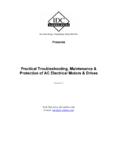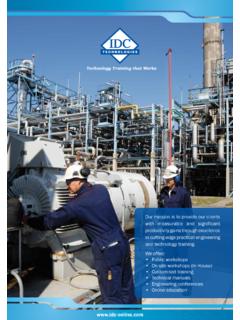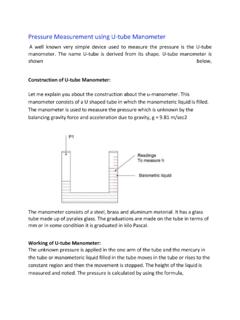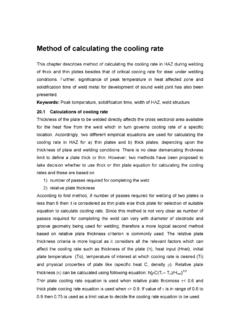Transcription of CAPACITOR & CAPACITANCE - HAZARDS AND SAFETY
1 CAPACITOR & CAPACITANCE - HAZARDS AND SAFETY HAZARDS and SAFETY capacitors may retain a charge long after power is removed from a circuit; this charge can cause shocks (sometimes fatal) or damage to connected equipment. For example, even a seemingly innocuous device such as a disposable camera flash unit powered by a volt AA battery contains a CAPACITOR which may be charged to over 300 volts. This is easily capable of delivering an extremely painful shock. Care must be taken to ensure that any large or high-voltage CAPACITOR is properly discharged before servicing the containing equipment. For board-level capacitors , this is done by placing a bleeder resistor across the terminals, whose resistance is large enough that the leakage current will not affect the circuit, but small enough to discharge the CAPACITOR shortly after power is removed.
2 High-voltage capacitors should be stored with the terminals shorted, since temporarily discharged capacitors can develop potentially dangerous voltages when the terminals are left open-circuited. Large oil-filled old capacitors must be disposed of properly as some contain polychlorinated biphenyls (PCBs). It is known that waste PCBs can leak into groundwater under landfills. If consumed by drinking contaminated water, PCBs are carcinogenic, even in very tiny amounts. If the CAPACITOR is physically large it is more likely to be dangerous and may require precautions in addition to those described above. New electrical components are no longer produced with PCBs. ("PCB" in electronics usually means printed circuit board, but the above usage is an exception.) capacitors containing PCB were labelled as containing "Askarel" and several other trade names.
3 High-voltage Above and beyond usual HAZARDS associated with working with high voltage, high energy circuits, there are a number of dangers that are specific to high voltage capacitors . High voltage capacitors may catastrophically fail when subjected to voltages or currents beyond their rating, or as they reach their normal end of life. Dielectric or metal interconnection failures may create arcing called an arc fault, within oil-filled units that vaporizes dielectric fluid, resulting in case bulging, rupture, or even an explosion that disperses flammable oil, starts fires, and damages nearby equipment, called flash - melt down, Rigid cased cylindrical glass or plastic cases are more prone to explosive rupture than rectangular cases due to an inability to easily expand under pressure. capacitors used in RF or sustained high current applications can overheat, especially in the center of the CAPACITOR rolls.
4 The trapped heat may cause rapid interior heating and destruction, even though the outer case remains relatively cool. capacitors used within high energy CAPACITOR banks can violently explode when a fault in one CAPACITOR causes sudden dumping of energy stored in the rest of the bank into the failing unit. And, high voltage vacuum capacitors can generate soft X-rays even during normal operation. Proper containment, fusing, and preventative maintenance can help to minimize these HAZARDS . High voltage capacitors can benefit from a pre-charge to limit in-rush currents at power-up of HVDC circuits. This will extend the life of the component and may mitigate high voltage HAZARDS . Source.
















